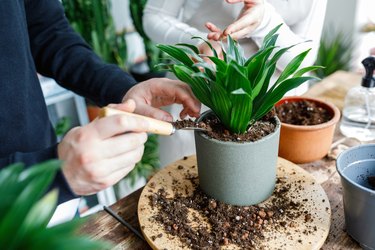
Finding grub worms in potted plants is not only alarming but can also be damaging to your plants. These pot worms are the larvae stage of beetles. Fortunately, there are several effective ways to control grubs and get them out of your potted plants.
Worms in Potted Plants
Video of the Day
There are several possible types of worms in potted plants. Typically, when you see a white grub, these are May beetles (Phyllophaga spp.), also called June beetles. The grubs feed on roots and pupate and emerge as adult beetles in May or June, giving the beetles their name. The adult beetles are brown in color and measure 1/2 to 1 inch long.
Video of the Day
While May beetle larvae are a common culprit, there are other beetle larvae that may appear as white grubs in your pots. The Japanese beetle (Popillia japonica) grows up to 1/2 inch long and has a metallic green body with brown wings. The larvae are nearly translucent at birth and grow up to 1 inch long with a yellowish-brown head. Masked chafers (Cyclocephala spp.) grubs are white in color when they hatch, but their bodies turn gray as they feed. Adults grow about 1/2 inch long and have a shiny red-brown body.
The adult green fruit beetle (Cotinis mutabilis) grows up to 1 1/3 inches long and is metallic green in color. The larvae may be dirty white or brown in color. Bumble flower beetles (Euphoria inda) are smaller in size, measuring up to 5/8 of an inch long. They are brown in color and covered in black dots. The larvae have a cream-colored body with a brown head and gray tail.
Pot Worms Damage
These plant worms or grubs are not good for your potted plants. Some species will feed on your plants' roots until they are ready to pupate and become adult beetles. This can decrease your plants' vigor and may cause the plants to start to lift from the soil.
Other grubs, such as green fruit beetle larvae, feed on decomposing material in the soil and don't damage the potted plants at all. That doesn't mean you should allow the larvae to live in your pots, however. After they pupate, some species of adult beetles will feed on the plants and fruits. In addition, females may lay more eggs in your pots, causing a bigger problem over time.
Controlling Grubs in Pots
These are several control options to consider to get rid of grubs in your potted plants. Chemical control methods can be effective for some beetles but aren't recommended for use on all beetle species, such as the green June beetle. If you do opt to use a chemical pesticide, carefully read and follow the product label. Make sure the product is effective against beetles and that it is safe for the plants you are growing in the container. Some chemicals to consider include bifenthrin, carbaryl and trichlorfon.
There are several biological controls that are effective for controlling grubs and are safer than chemical control options. For example, Bacillus thuringiensis, also known as Bt, is a bacteria that infects the larvae. Infected grubs become paralyzed and unable to feed. Make sure you select a strain of Bt that is effective against grubs. For example, Bt galleriae (Btg) is effective against Japanese beetle larvae, and Bt japonensis and kumamotoensis are effective against the northern masked chafer beetle.
Beneficial nematodes may also be a good biological control option. These organisms are microscopic round worms that carry a bacteria that infects and kills the grubs. As with Bt, it is important to select a nematode that will be effective against the specific grubs in your potted plants. Heterorhabditis bacteriophora is the nematode that is most effective against white grubs.
- University of Connecticut College of Agriculture, Health and Natural Resources: Bacillus Thuringiensis
- University of Connecticut Home & Garden Education Center: Beneficial Nematodes
- University of California Integrated Pest Management Program: Green Fruit Beetle — Cotinis Mutabilis
- Utah State University Cooperative Extension: Bumble Flower Beetle
- Clemson University Cooperative Extension: White Grub Management in Turfgrass